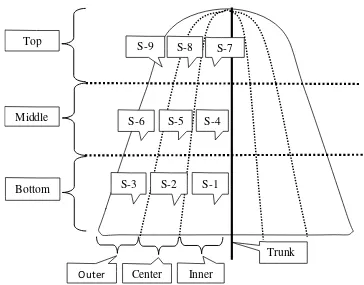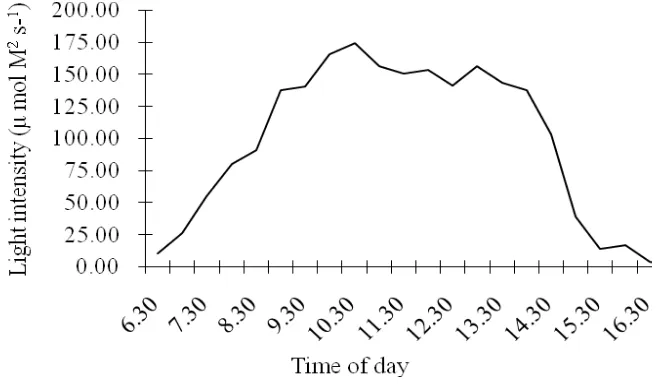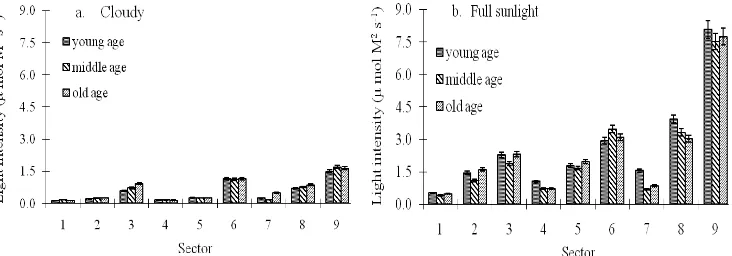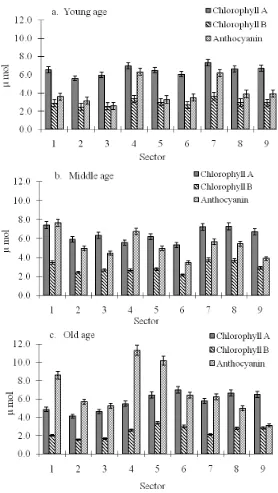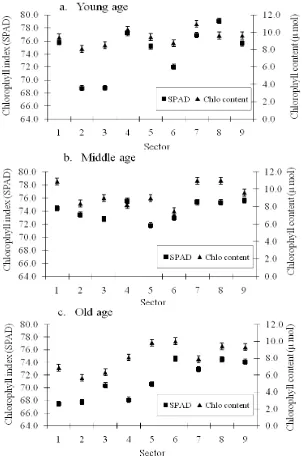10
Effect of Light Intensity to Chlorophyll and Anthocyanin Content
in Mangosteen Leaf
Eko Setiawan
Agrotechnology Department, University of Trunojoyo Madura [email protected]
Abstract
The objective of this study was to understand the light intensity conditions of mangosteen trees to various branch position in canopy. The experiment was conducted using mangosteen trees grown on commercial orchard in Bogor, Indonesia during August - October 2013. Mangosteen trees of three different ages, young (20 years), middle (35 years), and old ages (50 years), each of five trees, are selected for study. Canopy of each tree divided into 9 sectors. The highest light intensity in full sunlight conditions was found in sector 9 were 8.07; 7.53; and 7.74 μ mol M-2 s-1, in young, middle and old age, respectively, in contrast, the lowest light intensity in sector 1 were 0.53; 0.42; and 0.49 μ mol M-2 s-1, in young, middle and old age, respectively. Chlorophyll a/b ratio in mangosteen leaves increase gradually as an increase of age, each in young, middle, and old age were 2.20; 2.25; and 2.95, respectively. The highest chlorophyll index was in branch with fruit production, than decrease in dormancy condition, whereas the lowest chlorophyll index in new flush or vegetative condition.
INTRODUCTION
Mangosteen (Garcinia
mangostana L.) is a tropical evergreen tree, believed to have originated in the Sunda Islands and the Moluccas (Misra et al., 2009), growing in humid and shaded environmental conditions (Osman and Milan, 2006). Mangosteen, a slow-growing tree, is adapted to shade and regarded as a shade tolerant tree, while shade is essential during the first 2-4 years of growth (Nakasone and Paull, 1998). There are no reports of photoperiod response. The photosynthetic rate is steady over a 27-35°C temperature range, under 20-50% shade (Weibel et al., 1993). Fruit is susceptible to sunburn in direct sunlight (Verheij, 1992).
Mangosteen orchards in
Indonesia are generally found in villages and contain several fruit
species. Growing mangosteen
together with durian, rambutan or longkong is a common practice in
Thailand, because growers
experienced that the young plants require nurse trees or artificial shade
to encourage their growth
(Salakpetch, 2005). The objective of this study was to understand the light intensity conditions of mangosteen trees to various sector in canopy.
MATERIALS AND METHODS Plant material
The experiment was
conducted using mangosteen trees grown on commercial orchard in
Figure 1. Illustration of the sectors (positions in the canopy, S-1 to S-9) defined for study of mangosteen trees.
each tree divided into 9 sectors, such Sector 7 (inner top canopy); Sector 8 (center top canopy); and Sector 9 (outer top canopy) (Figure 1).
Light intensity and chlorophyll index
Light Intensity was monitored by Light Meter LI-250A (LI-COR) in
each sector per month. The
measurement light intensity in each sectors are in full sunlight and cloudy conditions. Using the young, middle, and old age trees, two leaves are collected from 9 sectors in September 2013. The chlorophyll index of leaf samples was measured by a chlorophyll-meter (SPAD-502, Minolta). The chlorophyll contents are determined used the same leaf above. Data were analysed using DSAASTAT.
RESULTS AND DISCUSSION Light intensity
Plant productivity associated
with the process of plant
photosynthesis. The light intensity in full sunlight in orchard conditions are presented in Figure 2. Light intensity at 6.30; 7.30; 8.30; 9.30 and 10.30 AM were 10.13; 54.55; 91.14; 140.30
and 174.38 μ mol M-2 s-1,
respectively and then gradually decrease because cloudy. Daily afternoon conditions in Bogor are cloudy and that followed by rainy.
Figure 3 a shows the light intensity in cloudy conditions. The highest light intensity in cloudy conditions in sector 9 were 0.31;
0.32; and 0.28 μ mol M-2 s-1 in
young, middle and old age,
respectively. That followed by sector 8, sector 6 and sector 3. Whereas the lowest light intensity in sector 1were
0.025; 0.03; and 0.021 μ mol M-2 s-1 in young, middle and old age, respectively.
Light intensity is not different significant in ages, but different significant in sector. The highest light
intensity in full sunlight conditions was found in sector 9 were 8.07;
7.53; and 7.74 μ mol M-2 s-1, in
young, middle and old age,
respectively (Figure 3b). That followed by sector 8 and sector 6. In contrast, the lowest light intensity in sector 1 were 0.53; 0.42; and 0.49 μ mol M-2 s-1, in young, middle and old age, respectively.
Chlorophyll and anthocyanin content
Chlorophyll contents are not different significant in ages, but different significant inter-sector. Figure 3 showed the highest chlorophyll a content in sector 3; sector 4; sector 5; sector 6; sector 7; sector 8; and sector 9 were 6.19; 5.85; 6.72; 5.94; 6.87; 6.87 and 6.78
μ mol, respectively. In contrast, the
lowest chlorophyll a contents in sector 1 and sector 2 were 5.58 and
5.35 μ mol, respectively. Chlorophyll b content are not different significant, highest in sector 7 and lowest in
sector 2 were 3.24 and 2.23 μ mol,
respectively.
Both chlorophyll a and b contents decreased gradually as an increase of ages. Average of chlorophyll a content gradually as a decrease of age in young, middle and
old age were 6.55; 6.44 and 5.72, respectively. Average of chlorophyll b content gradually as a decrease of age in young, middle and old age
were 3.05; 2.95 and 2.44,
respectively. Chlorophyll a/b ratio in
mangosteen leaves increase
gradually as an increase of age, each in young, middle, and old age were 2.20; 2.25; and 2.95, respectively. Chlorophyll total lowest in sector 2 and highest in sector 7 were 7.58 and
10.11μ mol, respectively.
Anthocyanin contents are not different significant both in ages and inter-sector. Figure 3a shows anthocyanin content in young age highest in sector 4 and sector 7, whereas lowest in sector 3 were 6.31;
6.19 and 2.59 μ mol, respectively.
Figure 3b shows the highest Anthocyanin content in middle age in sector 1, sector 4, sector 7 and sector
8 were 7.66; 6.76; 5.67; and 5.44 μ
mol, respectively. In contrast, the lowest Anthocyanin content in middle age in sector 6 and sector 9 were
3.48 and 3.91 μ mol, respectively. Figure 3c shows the highest Anthocyanin content in old age are in sector 1, sector 4 and sector 5 were
8.59; 11.30 and 10.18μ mol,
respectively. In contrast, the lowest Anthocyanin content in old age in
sector 9 and 8 were 3.11 and 4.98 μ
mol, respectively.
Figure 5 shows the
relationship between chlorophyll index and chlorophyll content in
leaves of mangosteen at various sector in canopy (a) young age, (b) middle age and (c) old age. Table 1 shows comparison of leaves season time of the presence on chlorophyll
Fig. 4 Comparison of chlorophyll and anthocyanin content in leaves of mangosteen at various sector in canopy (a) young age, (b) middle age
index of leaves. The highest chlorophyll index was in branch with fruit production, than decrease in dormancy condition, whereas the lowest chlorophyll index in new flush or vegetative condition.
The highest light intensity in full sunlight conditions was found in sector 9, in contrast, the lowest light intensity in sector 1. Sector 9, sector 6 and sector 3 are outer position in canopy get high light intensity
Fig. 5 The relationship between chlorophyll index and chlorophyll content
in leaves of mangosteen at various sector in canopy (a) young age,
because unshaded condition. In contrast sector 7, sector 4 and sector 1 are inner position in canopy get low light intensity because shaded condition. Ramlan (1992), reported increasing light intensity would result in increased value of photosynthesis when light saturation was achieved. Tabatabaei (2008), reported in both shaded and unshaded plants, the index of chlorophyll was increased with increasing NH4 ratio in the solution. The chlorophyll index (SPAD) in strawberrys were highest in unshaded condition and lowest in shade condition. Issarakraisila (2008), reported both chlorophyll a and b contents in mangosteen per fresh weight were low at full sun and increased gradually as an increase of light shading or lower light intensity. In this study shows both chlorophyll a and b contents decreased gradually as an increase of ages.
Issarakraisila (2008),
reported chlorophyll a/b ratio in mangosteen leaves seedlings was low with an average of 0.808. In this study shows chlorophyll a/b ratio in
mangosteen leaves increase
gradually as an increase of age, each in young, middle, and old age were 2.20; 2.25; and 2.95, respectively. This mean biggest canopy because increasing ages made dense inner canopy. Dense canopy structure of upper branches has inner and bottom
canopy protect from light availability (Setiawan, Poerwanto and Susanto, 2005). Atwell (1999), a lower a/b ratio reflects an increase in light harvesting chlorophyll II complexes relative to reaction centers since both chlorophyll a and b associated with light harvesting complexes, but only chlorophyll a was found in the reaction centers.
SUMMARY
Chlorophyll a/b ratio in mangosteen leaves increase gradually as an increase of age, each in young, middle, and old age were 2.20; 2.25; and 2.95, respectively. The highest chlorophyll index was in branch with fruit production, than decrease in dormancy condition, whereas the lowest chlorophyll index in new flush or vegetative condition.
REFERENCES
Atwell, B., Kriedejmann, P. and Turnbull, C. 1999. Plant in Action: Adaptation in Nature, Performance in Cultivation.
Macmillan Publishers,
Sydney, Australia.
Issarakraisila, M. and R. Settapakdee 2008. Effects of light intensity on leaf structure and growth of mangosteen seedlings. Acta Hort. 787: 289-292.
Table 1 Comparison of leaves season time of the presence on chlorophyll
index of leaves
Type of trees Leaves season time Chlorophyll index
(SPAD)
1 With fruit 71.77231
Dormancy 71.58503
New flush / vegetative 58.99455
2 With fruit 72.63910
Dormancy 70.93641
3 Dormancy 68.12375
Misra, H., B. K. Dwivedi, D. Mehta, B. K. Mehta, and D. C. Jain
2009. Development and
validation of high
performance thin-layer
chromatographic method for
determination of α-Mangostin
in fruit pericarp of
mangosteen plant (Garcinia
mangostana L.) using
ultraviolet – visible detection. Rec. Nat. Prod. 3 (4):178-186.
Nakasone, H. Y. and R. E. Paull
Centre for Underutilised
Crops, University of
Southampton, UK.
Ramlan, M.F., T.M.M. Mahmud, B.M. Hasan and M.Z. Karim. 1992. Studies on Photosynthesis on Young Mangosteen Plants Grown under Several Growth Conditions. Acta Hort. 321: 482-489.
Setiawan, E., R. Poerwanto and S. Susanto. 2005. Produktivitas
dan kualitas buah mangis pada berbagai posisi cabang dalam tajuk. J. Habitat 17 (3): 159-174.
Salakpetch, S. 2005. Mangosteen (Garcinia mangostana L.) Juvenility and Pruning in Thailand in Proceedings Fifteenth Annual International Tropical Fruit Conference. Hilo, Hawaii. p: 27-29.
Tabatabaei, S.J., M. Yusefi, and J. Hajiloo. 2008. Effects of shading and NO3:NH4 ratio on the yield, quality and N metabolism in strawberry. Scientia Hort. 116: 264–272.
